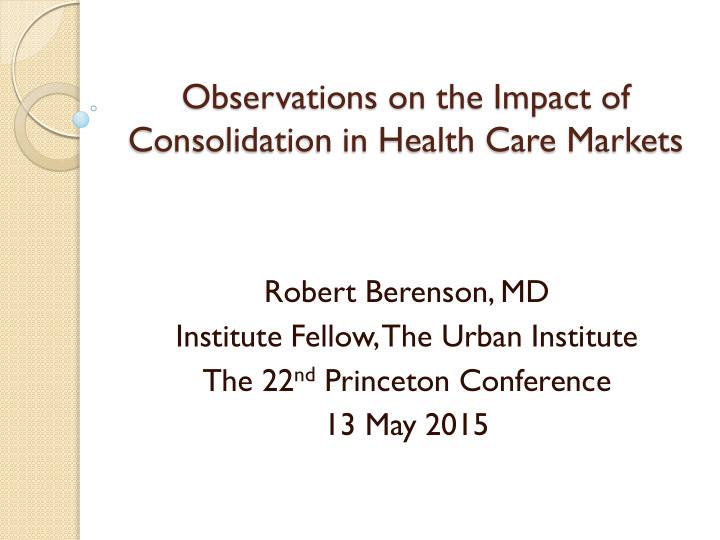



Observations on the Impact of Consolidation in Health Care Markets Robert Berenson, MD Institute Fellow, The Urban Institute The 22 nd Princeton Conference 13 May 2015
The major concern has been the impact of consolidation on prices High prices are the major reason US health care spending exceeds the rest of the world – “It’s the prices, stupid” -- Health Affairs, 2003; also, McKinsey Global Institute, 2008 Prices have been the main driver of recent growth in health spending, until very recently. ◦ Aggregate hospital payment-to-cost ratios for private payers increased from about 115% in 2000 to 149% in 2012. -- AHA Data Book Mass. Attorney General study in 2010 – hospital price variations are correlated with market leverage -- not quality, the characteristics of the populations served or their payment source, teaching or research, or even the hospitals’ actual costs.
The issue is not just high prices but huge price variations across and within markets Across 8 markets, avg. inpatient rates ranged from 147% of Medicare in Miami to 210% in SF, but included rates up to 500% for inpatient and 700% for outpatient care In LA County, 25 th percentile hospitals were paid at 84% of Medicare while hospitals at 75 th got 184% -- Center for Studying Health System Change Market participants commonly describe hospitals as “must - haves” and “have - nots,” with others in between There is less known about variations in payment for physicians, but I can make a case that many Miami physicians, as price-takers, accept about 70% of the Medicare fee schedule and physicians in a mid-west, multispecialty group, as price-makers, were able to negotiate 800%.
Market leverage to negotiate high prices is correlated with provider concentration Often resulting from merger and acquisition activity – in horizontal mergers of hospitals and now, again, vertical integration of hospitals, physicians, and maybe insurance Victor Fuchs in 1997 (JAMA) referred to a “stampede” to consolidation in response to managed care, and Leemore Dafny in 2014 (NEJM) described a “merger frenzy,” raising the question of whether there are unconsolidated hospital markets left. There are some. How about insurer consolidation? There has been plenty and increasing. But there is a Catch 22 here. Actively competing insurers want to get lower prices but lack the leverage to do so. A dominant insurer with little competition can drive prices lower but doesn’t have to – it only needs the “most favored” prices (with exceptions – see BCBS of Alabama).
The Synthesis Project (RWJF) – Update June 2012 (Gaynor and T own) Summary of key findings: Hospital consolidation generally results in higher 1. prices (and new, supportive evidence since 2012) Hospital competition improves quality of care 2. Physician-hospital consolidation has not led to either 3. improved quality or reduced costs Consolidation without integration does not improve 4. performance Consolidation between physicians and hospitals is 5. increasing (although for various reasons, including taking advantage of FFS payment rules, not only to form ACOs able to focus on population health) But let’s acknowledge that the literature is not robust, and this synthesis has been challenged by some
The limits of antitrust as the solution to high and variable provider pricing Only a relatively few M & A’s present good antitrust cases – hospitals often merge for perfectly good reasons Pricing power does not derive just from consolidation – reputation can be a reason and is supposed to be rewarded in markets Does not address the “ have-not ” providers Consolidation has already taken place in many markets – we have legally acquired oligopolies Forces pushing for consolidation are powerful and some are unrelated to pricing power issues Some visions of population-based health delivery see collaboration, rather than competition, as the dominant paradigm ◦
Recommend
More recommend